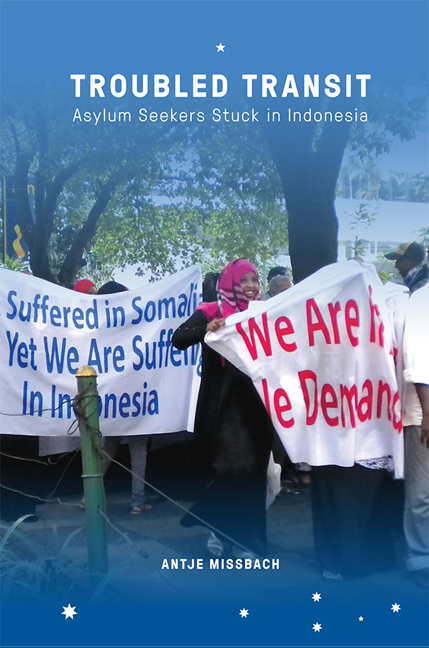Book contents
- Frontmatter
- Contents
- List of tables
- Acknowledgements
- Map of Indonesia
- Acronyms and Initialisms
- 1 Introduction
- 2 Transiting Indonesia: Past and Present
- 3 The Politics of Detention
- 4 Life on Hold
- 5 The Limits of Protection
- 6 Indonesia as a Transit State: Obligations, Policies, and Practice
- 7 Tidal Ebb and Flow: The Indonesia-Australia Relationship
- 8 Selling Hope
- 9 Conclusion
- Bibliography
- Index
- About the Author
- Frontmatter
- Contents
- List of tables
- Acknowledgements
- Map of Indonesia
- Acronyms and Initialisms
- 1 Introduction
- 2 Transiting Indonesia: Past and Present
- 3 The Politics of Detention
- 4 Life on Hold
- 5 The Limits of Protection
- 6 Indonesia as a Transit State: Obligations, Policies, and Practice
- 7 Tidal Ebb and Flow: The Indonesia-Australia Relationship
- 8 Selling Hope
- 9 Conclusion
- Bibliography
- Index
- About the Author
Summary
… in 25 march 2013 i left from indonesia
by ilegal boat and i have been in torture five days
in the oceon between kindari sulewesi
and to darwin, then australian navy caught us and servived us,
at the moment iam … still in camp
i hope that next month to come to Sydney.
(message forwarded by Ali through Facebook, 16 April 2013)
STUCK AGAIN
On a balmy autumn afternoon in 2014 in a not so cosy suburb in Western Sydney I am about to meet Ali, whose story this book begins with, again. A few weeks earlier, I received notice that he had finally been released from immigration detention in Darwin. Despite a number of failed attempts earlier on and “many litres of swallowed salt water”, as Ali put it, he had kept trying to reach Australia by boat. In April 2013, just a few months before the Australian government sealed its borders to maritime arrivals, Ali had eventually made it. The decision to risk his life, once again, on a tiny boat to cross the sea was anything but an easy one. Ali had spent years waiting for his proper resettlement as a recognized refugee. At times, when waiting became unbearable and he was about to lose hope, he had even contemplated returning voluntarily to Somalia, but the UNHCR would not approve this plan, leaving him stuck in Indonesia.
Having faced death once before on a sinking boat near Sumba, Ali was fully aware of the risks involved. When the prices charged by people smugglers dropped in early 2013 because of the very high demand for their services and a sort of “end-of-season sale”, Ali wanted to try his luck once more. He called a number of friends in Europe to lend him money and managed to scrape together AU$2,000. Just after he had paid the money collector, he got notice from the United States Embassy that he was invited for an interview to determine whether or not he could be resettled in the United States. Ali was torn: should he opt to continue the proper process, knowing that in the preceding four years only one Somali person had been approved for resettlement by any destination country?
- Type
- Chapter
- Information
- Troubled TransitAsylum Seekers Stuck in Indonesia, pp. 237 - 244Publisher: ISEAS–Yusof Ishak InstitutePrint publication year: 2015

